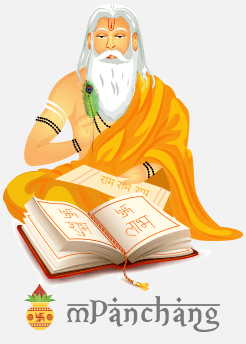Marathi New Year is celebrated nationwide on the day of Gudi Padwa. Marathi Shakha Samvat 1943 begins in the Pratipada Tithi of Tuesday, 8th of April 2024 from 11:00 pm and ends on 9th April 2024 at 08:30 pm.
Marathi New Year is the first day in the month of Chaitra of the year for the Maharashtrians and the Konkanis.
What is the significance of having a seperate New Year you may be thinking?
Well, to answer this question, I would want you to note that in India, most regions follow Lunisolar calendars or the Lunar calendar that works differently from the Solar calendar.
In India, this is traditionally followed differently by each of the cultural groups. Each group in India is self competent in having their own ways of following the calendars and the calculations.
Why do Marathis celebrate a seperate New Year
Every year marks the beginning of a new Samvatsara during the Marathi New Year and it is interesting to note that Samvatsara, is a different way of calculating life and the world. Samvatsara is the regular cycle of sixty years, and in this way there are 60 Samvatsaras in use. Once all these Samvatsaras come to an end, the Samvatsaras would begin again.
Know about the Sindhi New Year.
Samvatsara begins on the Marathi New Year day as per the Rig Veda and other ancient texts that highlight the Jupiter’s movement from one constellation to the other.
This Marathi New Year is known as the Jovian Year and has 361.027 days as per the Surya Siddhant. This is lesser by 4.5 days from the normal Solar calendar that we usually follow.
In order to make these two calendars, you have to skip one Jovian year each 85 year to make the two calendars seem similar.
The sixty Samvatsaras are divided into 20 each, making three separate units of Samvatsaras.
- The first 20 Samvatsaras are assigned to Brahma,
- The next 20 Samvatsaras are assigned to Vishnu and
- The last 20 Samvatsara are assigned to Shivay.
Ideally, we are still running in Vishnu’s cycle.
The Marathi New Year 2024 falls under the 33rd Samvatsara cycle that is called Vikari.
The Marathi New Year 2024 falls under the 34th Samvatsara Cycle and that is called Śārvarin.
There is a different level of energy each year as the Samvatsaras change from one to the other.
Cheti Chand is celebrated as Sindhi New Year's Day.
Personality Trait of People born in different Samvatsara.
Every cycle casts a different personality.
For example, the ones born during the Vikari would grow up to become extremely stubborn creatures. They would have the skills of different artistics forms. The would be more like a collector of things and would be blessed with a cunning mind, that deceives and is most often restless. They speak more than required and often do not believe their friends.
Similarly those who would be born in the Śārvarin cycle would be a skilled trader of times, is sensuous and pleasure seeking, and would prefer learning many things together.
Know about the Gujrati New Year.
All the Samvatsara Cycles would come to an end in the year 2046-2047 CE as per the Gregorian Calendar to begin again. Gudi padwa Marathi New Year is mainly based on these cycles. We would try to jot down each of the 20 names of each Brahma, Vishnu and Shiva's cycle below.
|
Brahma cycle |
Vishnu Cycle |
Shivay Cycle |
|
Prabhava |
Sarvajit |
Plavaṅga |
|
Vibhava |
Sarvadhārin |
Kīlaka |
|
Śukla |
Virodhin |
Saumya |
|
Pramodadūta |
Vikṛti |
Sādhāraṇa |
|
Prajāpati |
Khara |
Virodhakṛta |
|
Āṅgīrasa |
Nandana |
Paridhāvin |
|
Śrīmukha |
Vijaya |
Pramādin |
|
Bhāva |
Jaya |
Ānanda |
|
Yuva |
Manmatha |
Rākṣasa |
|
Dhātṛu |
Durmukha |
Nala/Anala |
|
Īśvara |
Hevilambi |
Piṅgala |
|
Bahudhānya |
Vilambi |
Kālayukta |
|
Pramāthi |
Vikāri |
Siddhārthin |
|
Vikrama |
Śārvarin |
Raudra |
|
Vṛushaprajā |
Plava |
Durmati |
|
Chitrabhānu |
Śubhakṛta |
Dundubhi |
|
Subhānu |
Śobhana |
Rudhirodgārin |
|
Tāraṇa |
Krodhin |
Raktākṣin |
|
Pārthiva |
Viśvāvasu |
Krodhana/Manyu |
|
Vyaya |
Parābhava |
Akshaya |
What do the Marathis do on this day?
On the occasion of Marathi New Year, the Marathis are busy creating a Gudi as the part of a celebration. A wooden pole is hanged close to their house or in the community. This top of the pole generally hoists a flag. The flags used are generally green, yellow, orange or white flags.
Here is Chaitra navratri daywise puja vidhi.
The colours are the significant colours of life. Green is the colour of fertility, orange is the colour of health. Yellow brings shine in lives and white brings peace in life. The flags are usually made of silk cloth. Some Neem leaves are hung from the Gudi, a garland is hung on the pole and it is made to stand straight. It is erected in memory of Lord Brahma.
The occasion of Gudi Padwa also commemorates the victory of Chatrapati Shivaji Maharaj. The Gudi also has a silver or metal pot on its head. Usually women wear the traditional Nathni and the Maharashtrian Saree. On this Marathi New Year, they would definitely make some Puran Poli, Shrikhand, Sunth Pak, Aambe Dal in their families which they savour after worshipping the Gods and Goddesses. The seniors of the family usually worship Laxmi, Saraswati and Ganesha for prosperity and for blessings.
In the evening communities usually take out processions, and the youth and the children dance to the tunes of the local songs. They dance and sing, and enjoy the entire evening with relatives, neighbours and friends visiting each other.
The farmers usually begin ploughing on the Marathi New Year day. It is considered to be an auspicious day to begin the ploughing of the fields. Several offerings are made to the deities, and these offerings generally consists of the flowers of Neem, jaggery, soaked pulses, cumin seeds and banana. Red flowers are also offered for prosperity to the deities. Beautiful Rangolis are created towards the celebrations of the Marathi New Year. Sometimes, there is a Rangoli competition held amongst women in the area or within colonies.
Know about the Diwali Festival calendar.
People nowadays even burst crackers, visit the nearby places, often carrying food to the popular tourist places where they enjoy, eat together and return back to their homes.
Common beliefs supporting the New Year celebrations
What are the common beliefs supporting the Marathi New Year?
- It is believed that Lord Brahma began crafting the world on this day of Marathi New Year. Brahma originated from the lotus dangling in the navel of Lord Vishnu.
- It is believed that Shri Ram returned to Ayodhya on this particular day of Gudi Padva or Marathi New Year. This day is celebrated everywhere in the country in some form or the other.
- Emperor Shalivahan defeated the Huns on this day.
Let us what they are called in different parts of the nations.
|
Gudi Padva in different parts of the country |
What are they called? |
|
Manipur |
Sajibu Nongma Panba Cheiraoba |
|
Kashmir |
Navreh |
|
Konkanis diaspora of Goa & Kerala |
Samvatsar Padvo |
|
Karnataka |
Yugadi |
|
Andhra Pradesh/Telangana |
Ugadi |
|
Sindhis |
Cheti Chand |
|
Kerala |
Vishu |
|
Punjab |
Vaisakhi |
So every Marathi New Year, there is a different Samvatsara and Gudi Padva, definitely ushers people into a new wave of energy. Equivalent to a year, the Samvatsaras help us recall a long gone period. The period of the Gods is remembered even today in India and thus Jupiter, the teacher of the Gods, moves around constellations which is still obeyed by some parts of the country.
Great celebrations mark the day, people often open new businesses, often buy gold and other valuables on this particular day. It is to note that even though our nation is so vast incorporating perhaps more than a hundred cultures, yet they synchronise and move together from one festival to the other. Call it Gudi Padva or the Sajibu Nongma Panba Cheiraoba or the Marathi New Year 2024, they may be named differently but they have some ways that match between different parts of the country. Thus, no matter which part of the country you are in, you can always celebrate the same festival in a different way amidst different flavours and tastes.
Happy Gudi Padwa Wishes and Messages
- “ROJULO prati kshanam Viluvinade.
UDAYAM HOPE to Modalite,
MADHYANAM FAITH vastundi.
SAYANTRAM LOVE Pondite,
RATRI REST nu Mosukostundi.
Evanni roju NEE JEEVITAM lo, Jaragalani Aasistu.” - May all the darkness get eliminated,
May all the hurdles get removed,
May all your wishes get fulfilled and
You get joy, wealth and happiness to the fullest.
Happy Gudi Padwa! - Let us bid goodbye to the past year and welcome the new year with great prosperity and warmth. Celebrate the new year and wish everyone a happy Gudi Padwa. Happy Gudi Padwa Greetings!!
- Happy Gudi Padwa! May on this festival of Gudi Padwa your life get filled with immense joy, happiness, wealth, prosperity and good health. Wishing you and your family a very happy Gudi Padwa.
- May God shower happiness, good luck and good health on the auspicious occasion of Gudi Padwa. May this new year you have full of new smiles, new success and new joys. Happy Gudi Padwa. Wishing you a very Gudi Padwa.
- Let the new year bring new reasons to smile and celebrate life. May you receive success in your endeavours and get opportunities to grow yourself. Wishing you a great luck this year to you and your family. Happy Gudi Padwa!


 ज्योतिषी से चैट करें
ज्योतिषी से चैट करें










Leave a Comment